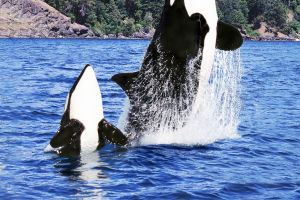
Dolphin Brain Adaptation

Dolphins, among the most intelligent creatures in the animal kingdom, exhibit a unique and fascinating behavior when it comes to sleep.
Unlike humans and most other animals, dolphins sleep with only one half of their brain at a time.
This phenomenon, known as unihemispheric slow-wave sleep (USWS), allows dolphins to remain partially conscious and perform essential functions while resting. This remarkable adaptation is a testament to the evolutionary ingenuity of marine mammals, highlighting their complex brain functions and survival strategies. USWS in dolphins involves one hemisphere of the brain entering a sleep state while the other remains awake and alert. This state is characterized by slow-wave activity in one hemisphere, indicative of deep sleep, while the other hemisphere shows wakeful patterns. During this time, one eye remains open and active, corresponding to the awake hemisphere, while the other eye is closed. Dolphins alternate between the hemispheres approximately every two hours, ensuring both sides of the brain receive adequate rest.
Related
 The battle-hardened killer whales have powerful enemies in the ocean.
The battle-hardened killer whales have powerful enemies in the ocean.
 A giant deer appeared! It weighs more than 1 ton and moves 15 meters in 1 second!
A giant deer appeared! It weighs more than 1 ton and moves 15 meters in 1 second!
 Did you know that camels can go days or weeks without eating or drinking?
Did you know that camels can go days or weeks without eating or drinking?
 Unexpectedly, a tiny dragonfly turned out to be the mysteries that have puzzled scientists for many years.
Unexpectedly, a tiny dragonfly turned out to be the mysteries that have puzzled scientists for many years.
 20 Cool Facts About Polar Bears That You Should Know.
20 Cool Facts About Polar Bears That You Should Know.
 British royal tradition: Swans symbolize wealth, protected for centuries by monarchs.
British royal tradition: Swans symbolize wealth, protected for centuries by monarchs.
The primary reason for this unique sleep pattern is survival. Dolphins are voluntary breathers, meaning they must consciously come to the surface to breathe air. If they were to enter a state of full sleep, they would risk drowning. By keeping one half of their brain awake, dolphins can continue to swim to the surface for air. This adaptation is crucial for their survival in the aquatic environment, where continuous movement and the ability to respond to threats are vital.

Furthermore, USWS allows dolphins to remain vigilant for predators. The ocean is home to numerous threats, such as sharks, and being able to detect and respond to these dangers is essential. By maintaining partial awareness, dolphins can react quickly to any potential threats. This heightened state of awareness also facilitates social interactions and communication within their pods. Dolphins are highly social animals, and the ability to maintain contact and coordinate movements, even during rest, strengthens their social bonds and enhances group cohesion.
The physiological mechanisms behind USWS are still not fully understood, but research suggests that it involves a complex interplay of neurochemical processes. Neurotransmitters such as GABA and acetylcholine play significant roles in regulating sleep and wakefulness in different brain regions. In dolphins, these processes are finely tuned to allow one hemisphere to rest while the other remains functional. This capability underscores the advanced nature of the dolphin brain and its evolutionary adaptations to marine life.
Dolphin sleep patterns have implications beyond mere survival. They offer insights into the broader study of sleep and brain function. Understanding USWS can shed light on the evolution of sleep in different species and the diverse strategies animals employ to balance rest with environmental demands. It also has potential implications for human health and medicine. Studying how dolphins manage sleep and wakefulness simultaneously could inspire new approaches to treating sleep disorders and improving brain health in humans.
This phenomenon raises intriguing questions about consciousness and awareness. Dolphins’ ability to remain partially aware while sleeping blurs the boundaries of our understanding of consciousness. It challenges the traditional dichotomy between wakefulness and sleep, suggesting that there can be intermediary states that serve adaptive functions. This opens up avenues for research into altered states of consciousness and the brain’s ability to function under varying levels of awareness.